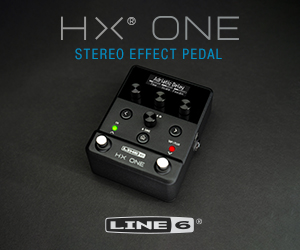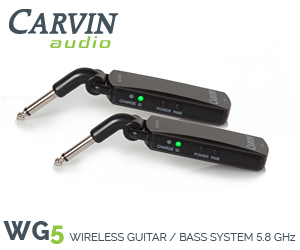An Audio Interface For Tone Hounds, Not Techies – IK Multimedia’s New AXE I/O
trushack | Jun 05, 2019 | Comments 0

The last time I bought an audio interface it felt like I was buying a toaster oven. Does it have the right features? Do people generally like it? Does it deliver good value for the money? Am I going to be able to comprehend the knobs and switches and lights adorning this thing? How many bagels can it toast at once?
Come to think of it, an interface that could properly toast a bagel would be pretty exciting. That technology probably needs several more years of development before it’s ready to bring to market, though. Otherwise, there was little excitement or enthusiasm on the part of your writer. No “man, I can’t wait to plug this in and rattle some windows,” or wondering what kind of new sounds I’ll be able to conjure up and what inspiration will spring from that. More like “eh, this looks like it’ll do the job and fits my budget.”
Fortunately for all tone hounds, IK Multimedia has put together an interface that leaves bland behind and spurs on those creative juices. The AXE I/O is an interface with functionality specifically designed for the recording guitarist, but offers flexibility that will excite even those who haven’t entered the realm of putting tone to tape (virtual or otherwise).
On the surface, it’s a 2 in/5 out unit with an array of routing options that handles the normal workload expected of any quality interface. The AXE I/O breaks away from the pack in a number of notable ways, however, starting at the very first point of connection. The main channel features “Z-Tone” control and options for different preamp circuit topologies and pickup types (active or passive).

The whole system is integrated with IK’s AmpliTube 4 Deluxe (included with the unit). The AmpliTube software was already renowned for its intuitive workflow and amazingly accurate sounds, and AmpliTube 4 takes the entire platform even higher. You get a swath of tonal variety by way of over 140 modeled components (expandable to over 300) that are easily configurable, in either traditional ways or truly custom arrangements. AmpliTube 4 also features a “cab room” that enables custom speaker options, dual micing in a three-dimensional setting, and six different room types with tweakable ambiance and control over the direct signal. Just about any cabinet/studio configuration you can think of can be recreated within AmpliTube 4. On top of that, AXE/IO owners also get a free selection of mixing, mastering, and effects plug-ins from IK Multimedia’s T RackS 5 plus Ableton’s Live 10 Lite digital audio workstation software, enabling professional-grade recording and production. Buying that software alone would cost almost as much as the AXE I/O unit itself!
So, a session with AXE I/O would typically look something like this: first, you plug your guitar of choice into the main input and adjust the input gain to your liking, as you’d do with a normal interface. Then, the fun begins. The Z-Tone control, in a nutshell, is an impedance control that can lean out or thicken your guitar’s base tone. The need to switch guitars for different parts is effectively eliminated just through this control. Say your tune calls for a chunky, warm rhythm sound combined with bright, stringy single-note lines that complement the vocal melody. With the AXE I/O, you can accomplish both with just one guitar, streamlining your tracking and keeping your head in the game.
Right under the Z-Tone control, you have switching options for pickup type (active or passive) and input stage type (“Pure” or “JFET”). Pickup type is pretty self-explanatory; flip the switch to optimize the AXE I/O’s response for whatever you happen to have loaded into your favorite guit-box. The input stage selector is used to further define the character of your tone; “Pure” provides a transparent and uncolored sound, while the “JFET” option adds dynamic, mid-focused, amp-like responsiveness that’s not typically not inherent in interface preamps.
This all happens before we get to the really rewarding bit; AmpliTube 4. The AXE I/O’s handy “Preset” knob, located right on the front of the unit, helps you quickly dial through the modeling software’s high quality models and options. Of course, once you find a model/setting you like you can go back to the main channel controls and refine your sound even further with the Z-Tone and preamp controls.

We’re not even done yet. Naturally, you get all the standard connection points and routing options for MIDI, monitors, and headphones that are part and parcel of any professional-level interface. The AXE I/O also simplifies re-amping via it’s dedicated “Amp Out” connection, however. Just record a clean base tone and use the Amp Out feature to run the signal through whatever external rig you can conjure up. If you want to go back to recording direct, no problem…you’re already running through the interface. You can leave all the futzing with noise, DI-boxes, and constant unplugging and re-plugging behind. You also have connection options for your favorite outboard hardware or even an expression pedal.
Did I mention the onboard tuner yet? Well, now I have!
Given the range of capability available in the AXE I/O, it’s priced well in line (and even below) many professional-grade interfaces that offer a fraction of the functionality but twice the learning curve. And even if you don’t do much recording, the AXE I/O lends itself extremely well to players that enjoy using modeling software to explore and build sounds. In fact, this writer believes it can make that playing experience even more rewarding and exciting. So even if you’re not quite up to speed on recording IK Multimedia’s AXE I/O is still an effective and inspiring tool for your virtual rig. It’s also dead-simple to use.
Oh, and one more thing, IK Multimedia: when you get around to perfecting the “AXEToast I/O” interface-toaster, I hope I’m the first one you call!
Tiny URL for this post:
About the Author:




















